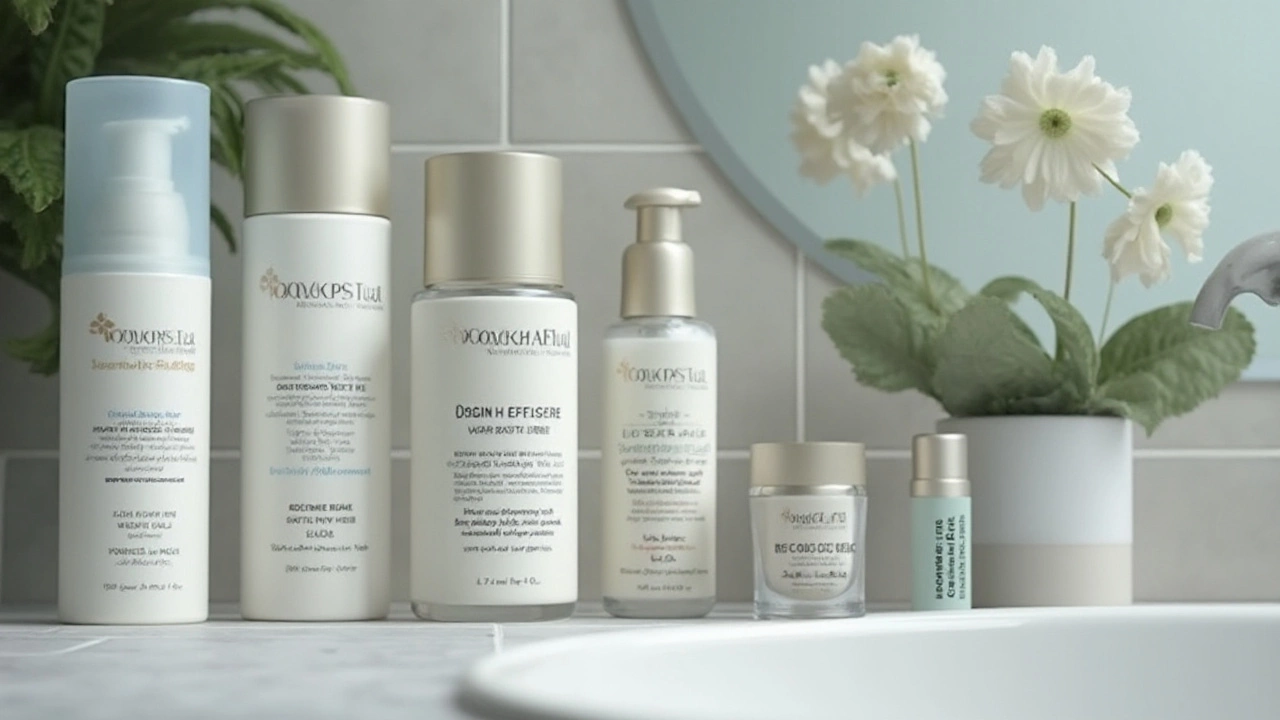Deep wrinkles often become a concern as we age, given they signal the skin's gradual shift over time. For those seeking ways to minimize these lines, the world of skincare offers many options, each claiming varying degrees of success. But navigating through these choices requires a clear understanding of what actually works.
In the pages that follow, we'll dive into the science of aging skin and uncover treatments that have shown promise, both in the lab and in people's lives. It's not just about creams and serums; innovative techniques and small tweaks in daily habits can also play a crucial role. Get ready to explore these avenues with an open mind and a focus on realistic outcomes.
- Understanding the Causes of Deep Wrinkles
- Popular Skincare Ingredients and Their Efficacy
- Innovative Treatments for Deep Wrinkles
- Lifestyle Changes to Help Reduce Wrinkles
- Myths and Facts About Wrinkle Treatments
Understanding the Causes of Deep Wrinkles
Deep wrinkles are more than mere lines on our skin; they narrate the story of time passing and are the testament to various intrinsic and extrinsic factors converging. While the aging process naturally thins the dermal layers and lessens collagen production, the causes of deep wrinkles are multifaceted. Primarily, changes at the cellular level, particularly the loss of collagen and elastin, lead to the skin losing its plumpness and elasticity. These structural proteins are integral for keeping skin resilient and smooth. Their decline, unfortunately, results in sagging and the formation of pronounced lines, which are most noticeably called wrinkles.
Environmental influences significantly hasten the wrinkle process. Sun exposure, for one, is a notorious culprit, accounting for up to 80% of skin aging signs. The ultraviolet (UV) rays damage skin fibers, making it slack and improperly supported, hence more prone to deep creases. This phenomenon, known as photoaging, is characterized by deep-set lines, discoloration, and a rough texture. It's a sobering reminder of how the sun's invisible rays can invisibly and subtly alter skin structure over time. Alongside UV exposure, environmental pollutants also play a crucial role, introducing free radicals that cause oxidative stress, deteriorating the skin's natural barriers.
Apart from external factors, lifestyle choices have a pronounced impact on wrinkle formation. Smoking is one such lifestyle choice that accelerates aging. The chemicals in tobacco smoke deprive the skin of oxygen, breaking down collagen, which results in not only lip lines or crow's feet but also more defined deep wrinkles. Similarly, diet plays a role; deficient nutrition deprives the skin of antioxidants and vitamins needed to maintain its health, resulting in dull, fragile skin appearance. Hydration, too, is vital, with dehydration exacerbating fine lines and making them deeper.
Genetics also cast their influence, acting as a roadmap for aging patterns, including when deep wrinkles might appear and their potential severity. If you observe your family members closely, patterns in wrinkle formation can be quite telling, signaling how familial factors may precondition the skin's aging response.
"Our genes determine how we age, but our lifestyle choices can speed up or slow down this process," says Dr. Alexis Abramson, a renowned gerontologist.
Interestingly, emotional expressions contribute too. Repeated muscle contractions from habitual facial expressions—be they frowns, smiles, or raised eyebrows—create creases in the epidermis. Over time, these lines develop into deeper imprints due to the underlying tissue memory.
In understanding these various determinants of deep wrinkles, one gains insight into mitigating them, nurturing a mindful approach to skincare. By acknowledging these root causes, it becomes possible to tailor a more personalized and effective skincare regimen that addresses not just the symptoms but the origin of wrinkle formation, helping to delay their progression and appearance.
Popular Skincare Ingredients and Their Efficacy
When it comes to tackling deep wrinkles, the spotlight often shines brightly on specific skincare ingredients renowned for their potency. Retinoids, a family that includes tretinoin and Retinol, consistently top the list. With roots deep in Vitamin A, these compounds effectively stimulate collagen production, a foundational protein responsible for our skin's youthful structure. It’s their ability to accelerate cell turnover that results in not only smoother skin but also refined texture. Because of this, dermatologists often recommend introducing retinoids gradually into one's routine to adjust and assess skin tolerance. Interestingly, in a famous study published in the journal of Dermatology, continuous use over six months showed visible improvement in wrinkle appearance.
Hyaluronic acid is another powerhouse ingredient, albeit it works in an entirely different manner than retinoids. Its mechanism is all about moisture retention. Known for its ability to hold up to 1,000 times its weight in water, hyaluronic acid ensures that skin remains hydrated and plump, effectively softening the appearance of wrinkle treatment areas. This ingredient often forms the backbone of many moisturizers aimed at mature skin. However, it's essential to combine it with good practices like consuming adequate water and maintaining general skin health through lifestyle choices.
Peptides are yet another critical player in the fight against anti-aging solutions. These short chains of amino acids are the building blocks of proteins like collagen and elastin. When applied topically, peptides can directly signal the skin to produce more collagen, bolstering the skin's natural repair process. This makes them an invaluable component in serums and creams tailored for aging skin. The effectiveness of peptides can vary, so seeking products with a suitable concentration and formulation is key. An intriguing point to note is the variety of peptides available, each serving slightly different functions, which makes them versatile tools in custom skincare regimens.
Among botanical ingredients, niacinamide, often known as Vitamin B3, stands out. It’s revered for its multipurpose benefits ranging from reducing inflammation to enhancing the barrier function of the skin. For those dealing with pigmentation alongside wrinkles, niacinamide offers a dual benefit with its ability to even out skin tone. Its soothing properties also make it an excellent addition for sensitive skin types. Dr. green, a well-known dermatologist, states, "Niacinamide not only fights numerous signs of aging but also bolsters the skin's defenses, making it resilient against environmental stressors." Such words highlight the holistic advantages few ingredients provide.
Of course, the synergy of these ingredients matters. Often, combining them can lead to more pronounced results. But it’s crucial to be aware of potential interactions, as not all ingredients blend well together. For example, while retinoids pair excellently with niacinamide, they might cause irritation when used alongside certain acids without caution. When navigating the dense landscape of skincare, knowledge about ingredient compatibility and personalized skincare strategies becomes indispensable. Simple yet effective steps such as patch testing and consulting with dermatologists ensure that each choice supports health rather than hinders progress. Exploring skincare isn't just about choosing an effective component; it’s about crafting a strategy that aligns with individual needs and goals.

Innovative Treatments for Deep Wrinkles
Deep wrinkles, etched through time and experience, are often candidates for more advanced interventions. In recent years, the field of skincare has witnessed a surge in novel therapies aimed at addressing these stubborn lines. One such method making waves is laser resurfacing. By using concentrated beams of light, this treatment encourages the skin to repair itself by producing new collagen. This protein is crucial for maintaining skin elasticity and firmness, both of which reduce as we age. Although heralded for its effectiveness, laser resurfacing requires a considerable downtime, as the skin heals and regenerates.
Another treatment gaining popularity is micro-needling. This process involves creating tiny punctures in the skin using fine needles, triggering the body's natural wound healing processes. The result is often smoother, firmer skin as collagen production kicks into overdrive. Micro-needling is sometimes combined with radiofrequency energy to further stimulate the skin. It's less invasive than lasers, with a quicker recovery time. For many, this option presents a middle ground between efficacy and recovery.
Chemical Peels and Fillers
Chemical peels offer another route for those tackling deep wrinkles. By applying a special chemical solution, top layers of skin are exfoliated and eventually peel off, revealing fresher skin beneath. This encourages new skin growth and can significantly reduce wrinkle depth. Peels come in different strengths, impacting their effectiveness and recovery time. Choosing the right peel typically depends on skin type and the depth of the wrinkles.
"In my practice, I’ve seen remarkable results with a combination of peels and micro-needling," says Dr. Isabelle Kling, a dermatologist based in Zurich, emphasizing the synergy between different treatments.
Dermal fillers have also become a mainstay among those aiming to fill in deep creases. These injectables, often composed of hyaluronic acid or similar substances, plump the skin from beneath, smoothing out deep lines. While their effects are not permanent, they do offer immediate results and can last from several months to over a year. The choice of filler and technique is crucial, requiring a skilled practitioner to achieve a natural look.
Emerging Technologies and Their Promise
Looking ahead, regenerative medicine is opening new horizons in wrinkle treatment. Stem cell therapy, albeit still in its infancy, shows promise in not only reducing wrinkles but enhancing skin health. By harnessing the body's ability to regenerate, these treatments aim to restore youthful skin function comprehensively. Another futuristic approach involves the use of bioengineered skin patches that deliver growth factors directly to problem areas, stimulating repair and regeneration at a cellular level.
For those exploring these wonderful skincare innovations, the initial step often involves a nuanced consultation with a skincare specialist. Understanding skin type, the degree of sun damage, and personal preferences can shape the most effective treatment plan. With technologies constantly evolving, staying informed ensures one navigates these choices with confidence.
Lifestyle Changes to Help Reduce Wrinkles
Addressing deep wrinkles isn't solely about the products we slather on our skin. In fact, daily habits and lifestyle choices can either exacerbate or alleviate the development of these unwanted lines. Embracing a skin-friendly lifestyle can have a profound impact on preserving the skin's youthful appearance. For starters, sunscreen is the ultimate warrior in any anti-aging arsenal. While it's well-known, many still underestimate its importance. Wearing a broad-spectrum SPF daily, regardless of the weather, can prevent the UV damage that leads to deeper furrows. Consistency here is key—making SPF application as habitual as brushing your teeth can award substantial benefits in the long term.
Let's talk about diet. The impact of nutrition on skin is profound. Nutrient-rich foods not only help maintain skin's elasticity but also keep it hydrated from within. Omega-3 fatty acids, found in fish like salmon and seeds like flaxseed, help fortify the skin’s barrier. These components are crucial for keeping moisture locked in and irritants out, thus softening deep lines. Additionally, vitamins A, C, and E act as antioxidants that fight free radicals—the culprits behind premature aging. Incorporating colorful fruits and vegetables into meals can be a delicious way to boost your skin's defense system. Hydration is another essential element. Drinking adequate water not only benefits your complexion but can also lend a healthy plumpness that diminishes the appearance of lines.
"Our lifestyle choices have a more significant impact on skin aging than genetics," says Dr. Sarah Wesley, a dermatologist and author on skin health. "Nurturing your skin through proper habits can delay the onset of deep wrinkles significantly."
No discussion about preventing wrinkles would be complete without highlighting the importance of quality sleep. In today’s fast-paced world, sleep often takes a backseat. However, during deep sleep stages, the body restores its cells, which includes skin cells. Lack of sleep can lead to high levels of cortisol, a stress hormone that can break down the skin's collagen, leading to exaggerated lines. Prioritizing a restful night means giving your skin the chance to repair itself and maintain its elasticity.
| Habit | Impact on Skin |
|---|---|
| Regular use of SPF | Prevents UV damage |
| Rich diet with antioxidants | Fights free radicals |
| Adequate hydration | Keeps skin plump and strong |
| Quality sleep | Permits cellular repair |
Reducing stress is just as vital. Chronic stress not only affects mental health but also accelerates the aging process. Techniques like meditation, yoga, and even regular exercise can promote relaxation and enhance blood circulation, supplying oxygen and nutrients to the skin. Speaking of exercise, physical activity increases blood flow, which helps nourish skin cells. This improved circulation means less buildup of waste products and radicals, which can both age the skin prematurely. Hence, an active lifestyle can be a game-changer in reducing visible aging signs.
Lastly, as we embrace all of these changes, let's not forget the power of habits like avoiding smoking and limiting alcohol. Both smoking and excessive alcohol consumption are infamous for robbing the skin of its vitality. Smoking reduces blood flow to the skin, depleting it of necessary nutrients and oxygen, while alcohol can lead to dehydration and dilated blood vessels, heightening the appearance of winkle treatment challenges.

Myths and Facts About Wrinkle Treatments
In the realm of deep wrinkles, it seems that myths abound, often leaving individuals confused about what genuinely works. One popular myth is that expensive treatments are always more effective than their cheaper counterparts. This belief can lead consumers to spend excessive amounts on high-end products without necessarily seeing better results. The truth is, effectiveness largely depends on the active ingredients and how they interact with your skin type. Whether a product costs ten or a hundred dollars, the formulas often aim to achieve the same goals: moisturizing, repairing, and boosting collagen production.
There's also a myth that natural remedies are insufficient in combating deep wrinkles. While it's true some natural ingredients may not be as potent as synthetic options in certain cases, numerous natural compounds have demonstrated significant efficacy. Ingredients like hyaluronic acid, retinol, and vitamin C—sometimes derived from natural sources—can play pivotal roles in reducing the appearance of wrinkles. The key is consistency in use and the suitability of the ingredient for your skin concerns.
"It's important to understand that no single ingredient or product is the magic cure for wrinkles," says Dr. Samantha Ellis, a leading dermatologist. "A combination of treatments is often necessary for optimal results."
Another persistent myth suggests that only topical treatments are necessary to address wrinkle treatment. While creams and serums are certainly valuable, they are only one part of the equation. Many dermatologists emphasize the necessity of a holistic approach, that includes diet, hydration, and sun protection, to achieve the most effective skin care results. Without safeguarding the skin from harmful UV rays or nourishing it from the inside out, topical treatments alone might not yield the desired effect.
Let's debunk the myth that once wrinkles appear, it's impossible to reduce their visibility significantly. Advances in anti-aging solutions have brought forth treatments like laser therapy and microneedling, which can promote collagen regeneration and enhance skin texture. While they might not erase wrinkles overnight, they can certainly make a noticeable difference in skin's appearance over time. Therefore, the myth that aging is irreversible should be reconsidered; science and technology provide a myriad of options for those willing to explore them.
Finally, the notion that youthful skin only comes from avoiding expressions or living without smiles is both misleading and impractical. While repetitive facial movements contribute to wrinkle formation, the emotional and psychological benefits of smiling far outweigh the superficial costs. Indeed, it's crucial to balance healthy skin practices with a life lived fully and joyously. After all, beauty is not just about appearance; it's deeply connected to wellbeing and happiness. By understanding these facts, we can better navigate the skincare landscape with confidence and knowledge.
